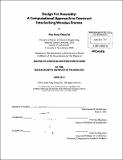Design for assembly : a computational approach to construct interlocking wooden frames
Author(s)
Tai, Alan Song-Ching
DownloadFull printable version (21.59Mb)
Alternative title
Computational approach to design interlocking wooden frames
Computational approach to construct interlocking wooden frames
Other Contributors
Massachusetts Institute of Technology. Dept. of Architecture.
Advisor
Takehiko Nagakura.
Terms of use
Metadata
Show full item recordAbstract
This thesis explores the computational process of generating and constructing interlocking frames. Its outcome delivers a sophisticated software tool that creates a three dimensional interlocking pattern, analyzes the intersecting conditions between members, and immediately provides instruction of its assembly sequence in animated visualization. An interlocking frame is a system that consists of short members spanning on a large surface where members lock each other at their mid-spans by simple notches. Such a system should be designed with consideration of its assembly sequence, as a static interlocking form may be described but impossible to assemble in any sequence. Given a three dimensional digital model of an interlocking frame, the feasibility of the disassembly sequence can be assessed by analyzing the geometric contact constraints between each member. The assembly sequence can then be obtained by reversing the disassembly sequence, and helps a designer to evaluate different options in the earlier stage of design. The proposed tool uses the genetic algorithm and graph searching algorithms to find optimized notching configurations that guarantee an assembly sequence. It can analyze various types of assemblies defined by planar surface contact constraints, and has a potential for further development into a versatile, automated 4D simulation tool.
Description
Thesis (S.M. in Architecture Studies)--Massachusetts Institute of Technology, Dept. of Architecture, 2012. Cataloged from PDF version of thesis. Includes bibliographical references (p. 48-49).
Date issued
2012Department
Massachusetts Institute of Technology. Department of ArchitecturePublisher
Massachusetts Institute of Technology
Keywords
Architecture.